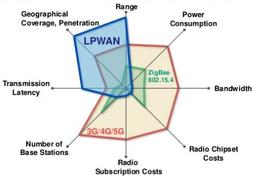5by5 Wireless Technology: IoT Fundamentals
Learn about 5by5 wireless technology, a low-power WAN for IoT, its features, specifications, and comparisons to other wireless technologies.
Showing 19 posts (Page 1 of 1)
Advertisement
Learn about 5by5 wireless technology, a low-power WAN for IoT, its features, specifications, and comparisons to other wireless technologies.

Explore the benefits and drawbacks of 6LoWPAN networks, including their use of IPv6, mesh topology, power consumption, and security aspects for IoT applications.

Explore the benefits and drawbacks of the MIPI CSI (Camera Serial Interface) for high-speed image and video transmission in various devices.

Explore 5 key advantages and disadvantages of ambient backscatter communication technology, highlighting its benefits and drawbacks as an innovative approach to wireless communication.
Explore the key features and benefits of the ARM Cortex-M85 processor, designed for endpoint AI, enhanced security, and efficient performance in embedded systems.
Atmel Corporation ships its new Atmel® SAM D20 microcontrollers. This is the first series in a new family of ultra-low power embedded Flash microcontrollers based on the ARM® Cortex®-M0+ processor.

Explore Bluetooth Low Energy (BLE) technology, including protocols, channels, and differences from classic Bluetooth. Learn how BLE optimizes power efficiency for IoT and wearable applications.

Explore CMOS op-amps: features, types, advantages, disadvantages, and applications. Learn how CMOS op-amps excel in low-power, high-density ICs.

Explore the pros and cons of Electronic Paper Display (EPD) technology, including low power consumption, excellent contrast, and limitations in refresh rate and color support.

A breakdown of LPDDR generations (1-5), covering clock frequencies, speeds, bus sizes, supply voltages, and prefetch sizes for mobile devices.

Explore the benefits and drawbacks of LPDDR5 RAM, a low-power memory standard used in mobile devices, focusing on speed, power consumption, and performance.

Explore the pros and cons of Low Power Wide Area Networks (LPWANs) for IoT, including range, power, cost, and limitations.
Microchip unveils the PIC24FJ128GC010 microcontroller, integrating a 16-bit ADC, high-speed ADC, DAC, USB, and LCD drivers on a single chip. Ideal for medical and industrial applications.
Explore power management techniques in ARM microcontrollers, including low-power modes, peripheral management, DVFS, and wake-up mechanisms for energy efficiency.
Explore the pros and cons of Sigfox wireless technology, covering its benefits, drawbacks, and limitations compared to other low-power, low-throughput solutions.
Texas Instruments releases MSP430F525x microcontrollers, designed to reduce power consumption in smartphones and tablets by enabling standby mode for power-hungry components.

Explore the pros and cons of WiFi HaLow (IEEE 802.11ah), including its low power consumption, extended range, and drawbacks like limited global standardization.

Explore the pros and cons of Zigbee technology, covering its features, benefits, and limitations for applications like home automation and IoT.

Explore Zigbee, a low-power WPAN tech designed for short-range IoT communication. Discover its features, benefits, and role in smart homes and industrial automation.
Advertisement